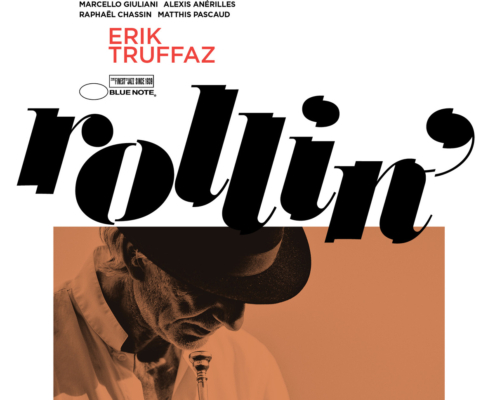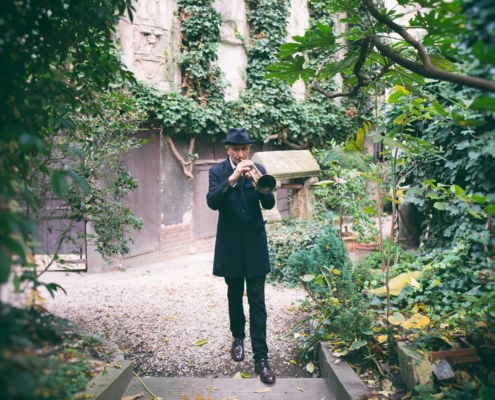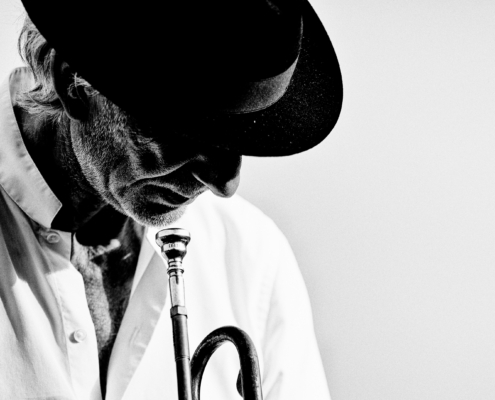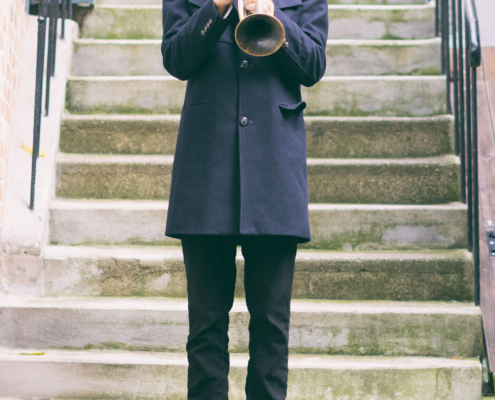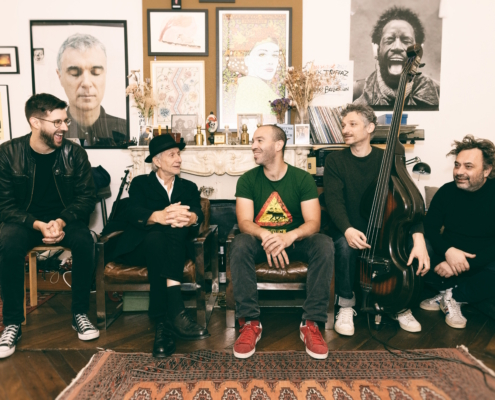Erik Truffaz – Rollin‘
- La Strada (Nino Rota)
- Route de nuit (Michel Magne)
- One Silver Dollar Camélia Jordana (Lionel Newman, Ken Darby)
- Thème de Fantômas (Michel Magne)
- Ascenseur pour l’échafaud (Miles Davis)
- Persuader’s Theme (John Barry)
- César et Rosalie feat. Sandrine Bonnaire (Philippe Sarde, Jean-Loup Dabadie)
- Le casse (Ennio Morricone)
- Quel temps fait-il à Paris? (Alain Romans)
Erik Truffaz – trumpet
Alexis Anérilles – Piano, Keyboards / Matthis Pascaud – Guitar
Marcello Giuliani – Bass, Double Bass / Raphaël Chassin – Drums
Erik Truffaz, 1960 in der Schweiz geborener französischer Jazztrompeter, bekennt sich seit langem zu seinem größten Vorbild Miles Davis. Seine Liebe zu dessen Klangsprache hört man seiner Musik an, ohne dass er dabei zu einem Epigonen oder gar Imitator wird. Auch die Klangästhetik eines Nils Petter Molvaer schwingt auf seinen Alben mit. Mit seinem neuesten Album „Rollin‘“ nimmt Truffaz seine Hörer jetzt mit in den abgedunkelten Kinosaal und führt ihnen mit seiner Musik unvergessene Filmklassiker vor Augen.
Sein atmosphärischer Kino-Jazz greift die Spannung, Melancholie und Faszination der Filme auf und führt sie durch Truffaz‘ Improvisation in teilweise überraschende Sphären. Natürlich darf Miles Davis‘ legendäres Thema aus „Fahrstuhl zum Schafott“ nicht fehlen, mit der Gänsehaut-Melodie aus „César et Rosalie“ (im Original gesprochen von Romy Schneider, hier interpretiert von der Schauspielerin Sandrine Bonnaire) und der Erkennungsmelodie des Super-Gangsters Fantomas bleibt Truffaz in Frankreich, während er mit Ennio-Morricone- und Nino-Rota-Werken den Hörer nach Italien und mit der Melodie zur TV-Serie „The Persuaders“ (auf Deutsch „Die Zwei“) nach England führt. Der Jazz und das Kino haben sich schon immer gegenseitig befruchtet und bleibende Eindrücke hinterlassen, Erik Truffaz führt diese Tradition jetzt auf zeitlos moderne Art fort.
Als Sohn eines Profimusikers trat Truffaz, noch bevor er sein erstes Lebensjahrzehnt beendet hatte, im Tanz-Orchester seines Vaters auf. Nach dem Besuch der Konservatorien von Genf und von Chambéry gründete er 1991 sein erstes Quintett und erspielte sich sogleich den Sonderpreis des Pariser Concours National de Jazz-Festivals. Zeitgleich begann er in der Hip-Hop-Formation „Silent Majority“ zu spielen. Seitdem trat er auch immer wieder mit DJs und Rappern auf. In seine Elektrojazz-Kompositionen mischt er Elemente von Hip Hop und elektronischer Musik.
INFO
It all began one festival night, Angoulême. The idea was for Erik Truffaz to un-play film music. Soundtracks are a delicate affair for musicians. They represent the skin of a film, its ill-defined soul; and in the worst screenplays they can constitute only decors for sentiments and feelings, and do hardly more than elevate the story. So Truffaz went off to rummage through his film-fan memories, his souvenirs from when he sat in a darkened cinema as a child or a teenage lover, and he organised this jazz tribute to the celluloid that it illuminates.
By way of an overture he opted for a monument. A tune from Nino Rota that does more than just fall inside the scope of the term “decoration”: obscure and palpitating, it is the very heart of La Strada. When Zampano collapses in tears on a beach embalmed by the night, stretched out in his old suit, when he casts a final look at the sky and the music melts, that tragic circus song… Erik Truffaz turns it into a lullaby. Strings draw taut in infinite tenderness and the trumpet caresses the theme in a prayer for love to last forever.
Something is evident right from the first piece. For „Rollin’”, Truffaz and his sidekick from almost way back when, Marcello Giuliani (they coproduced the album, which is as much as saying that this is a joint accomplishment), began by first putting down on paper a main-title that was ideal. If there’s one thing that strikes you about the career of Truffaz, it’s that casting-sense: don’t skimp on the supporting roles. Each of his records casts a troupe worthy of Marvel, with super-heroes playing textures and stylistic pile-ups. Here, in addition to the bass of Giuliani, who resorts to the acoustic variety, the group fills out with the ancient tubs of Raphaël Chassin, the land-mine keyboards of Alexis Anérilles, and the Monk-ish guitar played by Matthis Pascaud. And that’s precisely the gang that goes into town here and rearranges the portrait of a collection of photogenic music.
And here they come. Hey, they’re not there just to butter sandwiches. Erik Truffaz attacks Les Tontons Flingueurs via his taste for composer Michel Magne’s riffs, given a new lease of life by the Fender piano. It squeals, it bursts into flame, and it’s not so much a piece of quirky humour, more like venom. It ends up scattered all over like some kind of jigsaw puzzle.
The plot gradually establishes itself on this record as “Erik Truffaz interfering with every film in his life.” Anyone who’s seen him onstage will understand he’s a B-movie actor himself: fedora, the body of a beanpole, you don’t know whether he’s the goodie or the baddie, but he brings drama with him wherever he blows.
His trumpet is Robert Mitchum leaving the gambling table to hoover up Marilyn Monroe with his eyes, red corset and black feathers included. She sings a silver dollar and it’s our Marilyn, Camélia Jordana, same nonchalance, same bearing, who plays her role. The trumpet of Truffaz is by turns Louis de Funès, Jean Marais, against a Fantomas masked in green who’s brooding over global destruction inside a crypt with a mechanical pipe organ.
The brass jumps from one character to another, it’s the primary voice – never has the trumpeter sung so well as in these fictional avatars.
And then the Truffaz trumpet takes the liberty of donning the supreme costume that Miles Davis wore in Lift to the Scaffold, when the American musician was improvising opposite the immense face of Jeanne Moreau onscreen. This new reading is a lesson in itself, an Everest of swing and films, and it’s picked up with all the humility of climbs that are great.
Roll is also a game played by kids in the late afternoon, sitting round the television set to watch their heroes. They pick up Danny Wilde, Brett Sinclair, the main title as unforgettable as a warm scone after school, rewritten in a baroque septuple time. This is a record that doesn’t exclude low-grade serials and triumphant turnips, and still checks out films d’auteur, from Claude Sautet (with here the voice of Sandrine Bonnaire bearing the stamp of good sound in its corner), to that implausible tale of emeralds heisted by Belmondo and saved in extremis by the melodic genius of Ennio Morricone.
And so it is that this catalogue of music is not so much a lesson in films, but more a composers’ feast: Nino Rota, Michel Magne, Ennio Morricone, Alain Romans with Jacques Tati, Philippe Sarde, all the music-loving screenwriters, the geniuses of the superego whose scores massaged our imaginations. Roll has something of the freedom-fighters’ guerrilla: everywhere the group of Erik Truffaz appears, it sets the tunes free from their original function. These are no longer scores submitted to images, but miniature films that transcend the story. These are adventures that are unheard-of.
Weitere Infos in unserem Presseportal unter
https://journalistenlounge.de – bitte dort über den Genrefilter „Jazz“ anwählen!
Radio
Universal Music Jazz (Deutsche Grammophon GmbH)
Stralauer Allee 1, 10245 Berlin
Blue Note France / Universal Music
CD 00602455070487/ LP 00602455070500
VÖ: 07.04.2023

